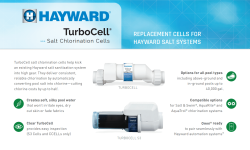- Aug 18, 2018
- 71
- Pool Size
- 13000
- Surface
- Fiberglass
- Chlorine
- Salt Water Generator
- SWG Type
- Hayward Aqua Rite (T-9)
Hi all,
I have a Prologic chlorination system (PL-P-4 model). I am looking to upgrade my salt cell at some point in the next 1-2 years. I want to upgrade with a Hayward product again. I have a turbocell T-9 now but want to upgrade to T-15 (40,000 gallon capacity). I notice that there are now multiple models to choose from and am not sure what are compatible with my prologic system. From what I can tell on the Hayward page, they all "could" be compatible with change in configuration at my control box.
My question - does anyone have any experience with the different models of salt cell and pros and cons of each:
model cell940 - 40000 gallons extended use
TcellS340 - 40000 clear view cell
W3t-cell-15 40000 standard - I think closest to what I have
Thanks
I have a Prologic chlorination system (PL-P-4 model). I am looking to upgrade my salt cell at some point in the next 1-2 years. I want to upgrade with a Hayward product again. I have a turbocell T-9 now but want to upgrade to T-15 (40,000 gallon capacity). I notice that there are now multiple models to choose from and am not sure what are compatible with my prologic system. From what I can tell on the Hayward page, they all "could" be compatible with change in configuration at my control box.
My question - does anyone have any experience with the different models of salt cell and pros and cons of each:
model cell940 - 40000 gallons extended use
TcellS340 - 40000 clear view cell
W3t-cell-15 40000 standard - I think closest to what I have
Thanks









